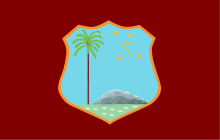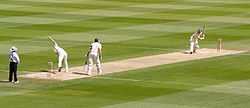Outline of cricket
The following outline is provided as an overview of and topical guide to cricket:
Cricket – a bat-and-ball team sport. Many variations exist, with its most popular form played on an oval-shaped outdoor arena known as a cricket field at the centre of which is a rectangular 22-yard (20.12 m) long pitch that is the focus of the game. A game (or match) is contested between two teams of eleven players each. One team bats, and will try to score as many runs as possible while the other team bowls and fields, trying to dismiss the batsmen and thus limit the runs scored by the batting team. A run is scored by the striking batsman hitting the ball with his bat, running to the opposite end of the pitch and touching the crease there without being dismissed. The teams switch between batting and fielding at the end of an innings.
What type of thing is cricket?
- Exercise – bodily activity that enhances or maintains physical fitness and overall health or wellness.
- Game – structured activity, usually undertaken for enjoyment and sometimes used as an educational tool. Games are distinct from work, which is usually carried out for remuneration, and from art, which is more concerned with the expression of ideas. However, the distinction is not clear-cut, and many games are also considered to be work (such as professional sports).
- Ball game – game played with a ball.
- Bat-and-ball game – field game played by two teams which alternate between "batting" and "fielding" roles. The fielding team defends, so only the batting team may score, but they have equal chances in both roles.
- Sport – form of physical activity which, through casual or organised participation, aim to use, maintain or improve physical fitness and provide entertainment to participants.
- Competitive sport – sport in which one or more participants or teams compete against one another. The one that is the most successful in achieving the objective of the game or sport event is the winner.
- Team sport – sport that involves players working together towards a shared objective.
- Recreational sport – sport engaged in as a leisure time activity.
- Spectator sport – sport that is characterized by the presence of spectators, or watchers, at its matches. Spectator sports are a form of entertainment.
- Professional sport – sport in which the athletes receive payment for their performance.
Forms of cricket
Classes of professional cricket
- International cricket
- Test cricket — The highest level of the sport, Test matches are played over a maximum of five days with two innings per side.
- One Day International (ODI) — International matches played with one innings per side, fixed at 50 overs.
- Twenty20 International — International matches played with one innings per side, fixed at 20 overs.
- Domestic cricket — cricket as played within a particular country.
- First class cricket — Similar to Test cricket, these matches are player over three or more days with two innings per side.
- List-A cricket — Similar to ODI, matches are played with one innings per side of a fixed number of overs, usually between 40 and 60.
- Twenty20 — Matches played with one 20 over innings per side.
- Club cricket — mainly amateur, but still formal, form of the game, usually involving teams playing in competitions at weekends or in the evening.
Other forms of cricket
- Kwik cricket — a high-speed version of cricket aimed mainly at encouraging children to take part in the main sport. Known as MILO Kanga cricket in Australia, and MILO Kiwi Cricket in New Zealand.
- Backyard cricket — also known as "street cricket", "beach cricket", "gully cricket", and "garden cricket", it is an informal ad hoc variant of the game of cricket, played by people of both sexes and all ages in gardens, back yards, on the street, in parks, carparks, beaches and any area not specifically intended for the purpose.
- French cricket — informal variation, in which there is only one batsman, the objective of whom is not to be dismissed by the other participants - who are fielders, or a bowler if they have possession of the ball - for as long as possible.
Equipment of the game
- Cricket ball — hard solid ball constructed of cork and leather, used to play cricket.
- Cricket bat — specialised wooden bat used to strike the ball.
- Cricket field —
- Cricket Whites - the traditional uniform worn.
- Stump - the target, at which the bowler aims
- Bail (cricket) - the small items on the stumps, which the bowler is aiming to dislodge
Training and practice equipment
- Bowling machine — device which enables a batsman to practice (usually in the nets) and to hone specific skills through repetition of the ball being bowled at a certain length, line and speed. It can also be used when there is no-one available to bowl, or no one of the desired style or standard.
Rules of the game
- Dismissal — occurs when the batsman is out (also known as the fielding side taking a wicket and/or the batting side losing a wicket). Colloquially, the fielding team is also said to have snared, bagged or captured a wicket. At this point a batsman must discontinue batting and leave the field permanently for the innings.
- Innings —
- Appeal — the act of a bowler or fielder shouting at the umpire to ask if his last ball took the batsman's wicket. Usually phrased in the form of howzat (how-is-that?). Common variations include 'Howzee?' (how is he?), or simply turning to the umpire and shouting.[1] The batsman will not be given out without an appeal, even if the criteria for a dismissal have otherwise been met.
Game play
- Batting — the act or skill of hitting the cricket ball with a cricket bat to score runs or prevent the loss of one's wicket.
- Bowling — the act of delivering the ball to the batsman with the aim of getting him out, or preventing him from scoring.
- Fielding — the act of operating in the cricket field to retrieve the ball, facilitate a run out or catch, or prevent scoring opportunities.
Cricket, by region
Cricket by country |
|---|
| | Full ICC Members | |
|---|
| | Associate Members | |
|---|
| | Affiliate Members | |
|---|
| | Non-members | |
|---|
|
- Cricket in Africa
- Cricket in Asia
|
|
- Cricket in North America
- Cricket in Oceania
|
History of cricket
Professional cricket
International cricket
- Structure of international cricket
International cricket teams
-
 Australia (5 January 1971)
Australia (5 January 1971)
-
 England (5 January 1971)
England (5 January 1971)
-
 New Zealand (11 February 1973)
New Zealand (11 February 1973)
-
 Pakistan (11 February 1973)
Pakistan (11 February 1973)
-
 West Indies (5 September 1973)
West Indies (5 September 1973)
-
 India (13 July 1974)
India (13 July 1974)
-
 Sri Lanka (7 June 1975)
Sri Lanka (7 June 1975)
-
 Zimbabwe (9 June 1983)
Zimbabwe (9 June 1983)
-
 Bangladesh (31 March 1986)
Bangladesh (31 March 1986)
-
 South Africa (10 November 1991)
South Africa (10 November 1991)
The ICC temporarily grants ODI status to other teams; at present these are:
-
 Kenya (from 18 February 1996, until the 2013 ICC World Cup Qualifier)
Kenya (from 18 February 1996, until the 2013 ICC World Cup Qualifier)
-
 Canada (from 1 January 2006 until the 2013 ICC World Cup Qualifier)
Canada (from 1 January 2006 until the 2013 ICC World Cup Qualifier)
-
 Ireland (from 1 January 2006 until the 2013 ICC World Cup Qualifier)
Ireland (from 1 January 2006 until the 2013 ICC World Cup Qualifier)
-
 Netherlands (from 1 January 2006 until the 2013 ICC World Cup Qualifier)
Netherlands (from 1 January 2006 until the 2013 ICC World Cup Qualifier)
-
 Scotland (from 1 January 2006 until the 2013 ICC World Cup Qualifier)
Scotland (from 1 January 2006 until the 2013 ICC World Cup Qualifier)
-
 Afghanistan (from 19 April 2009 until the 2013 ICC World Cup Qualifier)
Afghanistan (from 19 April 2009 until the 2013 ICC World Cup Qualifier)
Players
See also
Notes
- ↑ Barclays World of Cricket – 2nd Edition, 1980, Collins Publishers, ISBN 0-00-216349-7, pp 636–643.
References
- H S Altham, A History of Cricket, Volume 1 (to 1914), George Allen & Unwin, 1962
- Derek Birley, A Social History of English Cricket, Aurum, 1999
- Rowland Bowen, Cricket: A History of its Growth and Development, Eyre & Spottiswoode, 1970
- Wisden Cricketers Almanack (annual): various editions
External links
Outlines |
|---|
| General reference
- Culture and the arts
- Geography and places
- Health and fitness
- History and events
- Mathematics and logic
- Natural and physical sciences
- People and self
- Philosophy and thinking
- Religion and belief systems
- Society and social sciences
- Technology and applied sciences
|
|
 Australia (5 January 1971)
Australia (5 January 1971) England (5 January 1971)
England (5 January 1971) New Zealand (11 February 1973)
New Zealand (11 February 1973) Pakistan (11 February 1973)
Pakistan (11 February 1973) West Indies (5 September 1973)
West Indies (5 September 1973) India (13 July 1974)
India (13 July 1974) Sri Lanka (7 June 1975)
Sri Lanka (7 June 1975) Zimbabwe (9 June 1983)
Zimbabwe (9 June 1983) Bangladesh (31 March 1986)
Bangladesh (31 March 1986) South Africa (10 November 1991)
South Africa (10 November 1991) Kenya (from 18 February 1996, until the 2013 ICC World Cup Qualifier)
Kenya (from 18 February 1996, until the 2013 ICC World Cup Qualifier) Canada (from 1 January 2006 until the 2013 ICC World Cup Qualifier)
Canada (from 1 January 2006 until the 2013 ICC World Cup Qualifier) Ireland (from 1 January 2006 until the 2013 ICC World Cup Qualifier)
Ireland (from 1 January 2006 until the 2013 ICC World Cup Qualifier) Netherlands (from 1 January 2006 until the 2013 ICC World Cup Qualifier)
Netherlands (from 1 January 2006 until the 2013 ICC World Cup Qualifier) Scotland (from 1 January 2006 until the 2013 ICC World Cup Qualifier)
Scotland (from 1 January 2006 until the 2013 ICC World Cup Qualifier) Afghanistan (from 19 April 2009 until the 2013 ICC World Cup Qualifier)
Afghanistan (from 19 April 2009 until the 2013 ICC World Cup Qualifier)